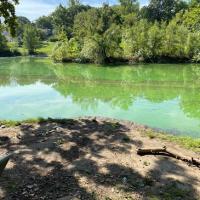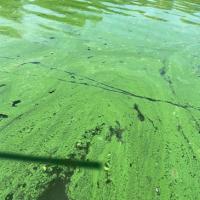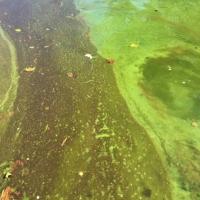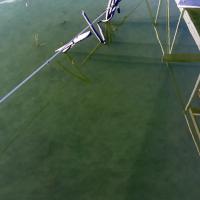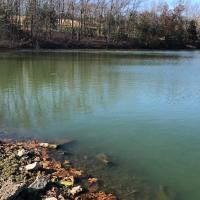Cyanobacteria, also known as blue-green algae, are not actually algae. They are a type of bacteria that can “bloom” like algae when the conditions are right. Cyanobacteria blooms can be a variety of colors, such as bright green, blue-green, white, red or yellowish-brown. The water may look like pea soup or the surface may look as if paint has been spilled on the water. They may or may not have thick scums or foam. As the cyanobacteria begin dying and decomposing they may release an unpleasant odor similar to rotting plants.
Lakes and ponds are the most likely waterbodies to experience blooms, but they also can occur in streams, especially if they are slow moving or pooled. Many cyanobacteria can sink or float to control their location in the water column, so a bloom can appear to move and change quickly. Other factors, such as wind, rain, wakes from recreational activities and currents, can also affect the location of a bloom or how it appears. The photo gallery below shows examples of typical Missouri cyanobacterial blooms.
Reporting
So how do you know if a bloom is cyanobacteria or not? Unfortunately, you cannot tell if an algal bloom is harmful or not just by looking at it. If you believe you have observed a potentially harmful algal bloom, please report the bloom. For general information about harmful algal blooms, visit the department's Harmful Algal Blooms (HABs) webpage.

Concerns
Algal blooms caused by cyanobacteria are especially concerning because they are capable of producing toxins that can be harmful, even lethal, to humans, livestock and pets. A wide variety of cyanobacteria species produce poisons known as cyanotoxins and some even produce more than one type of cyanotoxin. The most common toxins produced in Missouri are microcystins, cylindrospermopsin, anatoxins and saxitoxins. To learn more about these toxins, visit EPA's Learn about Harmful Algae, Cyanobacteria and Cyanotoxins webpage.
Scientists do not fully understand what causes cyanobacteria to produce toxins. It could be an environmental change or a natural need to out-compete other organism in the waterbody for food or light. Regardless, if you come across areas of thick algae, take precaution by avoiding water contact and keeping pets out of the water. Please follow the links below for more information about how to avoid exposure, the different symptoms of exposure and steps to take if a person or animal is showing signs of exposure.
- Harmful Algal Blooms and Human Health - Includes resources for Poison Center and medical professionals
- Harmful Algal Blooms and Animal Health - Includes resources for veterinarians and other animal health professionals
Photo Gallery
Resources
The links provide additional resources that contain photo examples of both cyanobacteria and non-blue-green algae.
- Field and Laboratory Guide to Freshwater Cyanobacteria Harmful Algal Blooms for Native American and Alaska Native Communities - USGS
- Non-cyanobacteria Blooms
Landowners and Waterbody Managers
- Algal Control - MDC
- Blue Green Algae & Me - DHSS
- Blue-Green Algae in Missouri - LMVP
- Cyanobacterial (Blue-Green Algal) Blooms: Tastes, Odors, and Toxins - USGS
- Harmful Algal Bloom Control Methods - NEIWPCC
- Harmful Algal Blooms - NOAA
- Harmful Algal Blooms (HABS) - ASDWA
- Harmful Algal Blooms and Blue-green Algae - PUB3051
- Harmful Algal Blooms (HABs) in Water Bodies - EPA
- Look Out Harmful Algal Blooms - PUB2889
- Natural Water Areas - DHSS
- Strategies for Preventing and Managing Harmful Cyanobacterial Blooms - ITRC
- Visually Identifying Signs of a Cyanobacterial Bloom - EPA
- What makes blue-green algae dangerous? - ACS
- Algal Blooms Can Harm Your Health - EPA video
- Harmful Algal Blooms and Health - CDC video
- What Makes Blue-Green Algae Dangerous? Speaking of Chemistry - ACS video
Testing
- The Jar and Stick Test - KDHE
- Laboratories that Analyze for Cyanobacteria and Cyanotoxins - EPA
- MDNR-ESP-360: Qualitative Screening of Algal Toxins in Drinking and Recreational Waters Using Strip Tests by Gold Standard Diagnostics
- MDNR-ESP-370: Sample Collection and Handling of Cyanobacteria for Identification, Enumeration, and Cyanotoxin Analysis
Communication Resources
- Communicating about Cyanobacterial Blooms and Toxins in Recreational Waters - EPA
- Communication Resources - CDC
- Drinking Water Advisory Communication Toolbox - CDC
- Harmful Algal Blooms: Social Media Toolkit - CDC
Drinking Water Information
- 2015 Drinking Water Health Advisories for Two Cyanobacterial Toxins - EPA
- Harmful Algal Bloom Sampling Protocol
- Managing Cyanotoxins in Public Drinking Water Systems - EPA
- Managing Cyanotoxins in Drinking Water: A Technical Guidance Manual for Drinking Water Professionals - Water Research Foundation
- Removal of Algal Toxins from Drinking Water Using Ozone and GAC - Water Research Foundation
- Treating Algal Toxins Using Oxidation, Adsorption, and Membrane Technologies - Water Research Foundation
- Evaluation of Integrated Membranes for Taste and Odor and Algal Toxin Control - Water Research Foundation
- Rapid Detection of Cyanobacterial By-Products in Drinking Water - Water Research Foundation
Recreational Water Information
- Recommendations for Cyanobacteria and Cyanotoxin Monitoring in Recreational Waters - EPA
- EPA Tools for Waterbody Managers to Monitor for and Respond to CyanoHABs
- 2019 Recreational Water Quality Criteria or Swimming Advisories for Cyanotoxins - EPA
- World Health Organization (WHO) 1999 Guideline Values for Cyanobacteria in Freshwater - EPA
- Reservoir Management Strategies for the Control and Degradation of Algal Toxins - Water Research Foundation
Popular Links
Navigation
Contact Information
Environmental Services Program
Division of Environmental Quality
P.O. Box 176
Jefferson City, MO 65102-0176
United States




